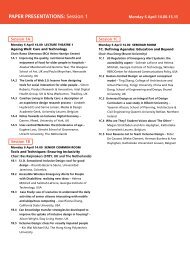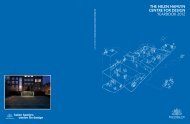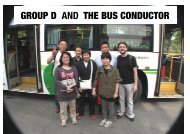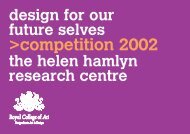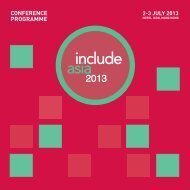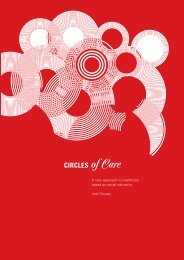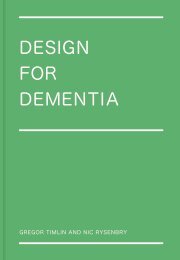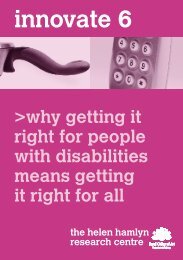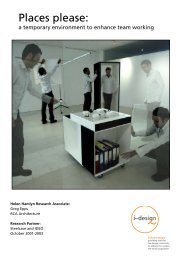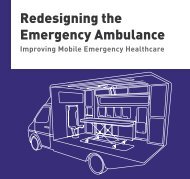Sensory devices: - Helen Hamlyn Centre - Royal College of Art
Sensory devices: - Helen Hamlyn Centre - Royal College of Art
Sensory devices: - Helen Hamlyn Centre - Royal College of Art
You also want an ePaper? Increase the reach of your titles
YUMPU automatically turns print PDFs into web optimized ePapers that Google loves.
<strong>Sensory</strong> <strong>devices</strong>:<br />
communication in domestic appliances to aid use by<br />
older people<br />
<strong>Helen</strong> <strong>Hamlyn</strong> Research Associate:<br />
Bryn Griffiths<br />
RCA Industrial Design Engineering<br />
Research Partner:<br />
Dyson Research<br />
October 2000
i~design case studies<br />
This is one <strong>of</strong> a series <strong>of</strong> inclusive design case<br />
studies published as part <strong>of</strong> the i~design research<br />
programme. These case studies document inclusive<br />
design collaborations between the <strong>Helen</strong> <strong>Hamlyn</strong><br />
<strong>Centre</strong> (HHC) and industry and voluntary sector<br />
partners, under the <strong>Helen</strong> <strong>Hamlyn</strong> Research<br />
Associates programme. They also document the<br />
results <strong>of</strong> the ‘Inclusive Design Challenge’, a<br />
design competition co-ordinated by the <strong>Helen</strong><br />
<strong>Hamlyn</strong> Research <strong>Centre</strong> and the Design Business<br />
Association.<br />
i~design is a multi-centre collaborative research<br />
programme funded by the Engineering and Physical<br />
Sciences Research Council (EPSRC). The purpose<br />
is to foster the adoption <strong>of</strong> inclusive design by<br />
business decision makers and pr<strong>of</strong>essional designers,<br />
in particular by presenting the business case,<br />
developing tools and techniques, and building<br />
a network <strong>of</strong> researchers around the projects.<br />
i~design partners<br />
• The <strong>Helen</strong> <strong>Hamlyn</strong> <strong>Centre</strong> at the <strong>Royal</strong> <strong>College</strong> <strong>of</strong><br />
<strong>Art</strong>, London, is a centre for inclusive design, with<br />
extensive contacts in industry and<br />
design pr<strong>of</strong>essions.<br />
• The Engineering Design <strong>Centre</strong> at the University<br />
<strong>of</strong> Cambridge has a strong reputation in<br />
the improvement <strong>of</strong> design process and<br />
development <strong>of</strong> design methodologies<br />
to address specific issues.<br />
• Applied Computing at the University <strong>of</strong> Dundee<br />
develops information technology systems to<br />
support older and disabled people.<br />
• The HCI Group at the University <strong>of</strong> York has<br />
a long history <strong>of</strong> inter-disciplinary research<br />
in the area <strong>of</strong> user centred design arising from<br />
collaboration between the departments <strong>of</strong><br />
Psychology and Computer Science.<br />
• The Design Council inspires and enables the<br />
basic use <strong>of</strong> design by business, education<br />
and government to improve prosperity and<br />
well-being.
<strong>Sensory</strong> <strong>devices</strong>:<br />
communication in domestic appliances to aid use by<br />
older people<br />
Abstract<br />
It is <strong>of</strong>ten the familiarity <strong>of</strong> everyday domestic appliances which obscures shortcomings in the<br />
way they operate. The physical interfaces <strong>of</strong> such products as vacuum cleaners, kettles and<br />
washing machines remain unchanged and unyielding to older users in particular, while newer<br />
product categories afford much easier interaction. This applied research study investigates<br />
new ways to communicate the product functions <strong>of</strong> Dyson vacuum cleaners to older users (Fig<br />
8). More than a quarter <strong>of</strong> Dyson’s customers are aged 55 and over and through this project<br />
Dyson Research has a new road map for future development <strong>of</strong> new features to aid older<br />
users. Many <strong>of</strong> the findings are much more widely applicable. Product communication audits,<br />
ethnographic and other research findings were mapped against a parallel investigation <strong>of</strong><br />
automotive interface issues to produce a set <strong>of</strong> guidelines for inclusive design. Such issues as<br />
form, colour, orientation, consistency and commonality <strong>of</strong> features, signs and symbols, and<br />
reassurance through other senses were mapped and used to help direct the design process. A<br />
series <strong>of</strong> design proposals then showed how audio and textural sensory <strong>devices</strong> can be incorporated<br />
to improve the ease <strong>of</strong> use <strong>of</strong> domestic appliances for all. Concepts include polymers,<br />
which change colour when appliances get hot, sound reeds which emit audio signals and buttons<br />
that deploy textural contrasts and vibration in use.<br />
Keywords<br />
Domestic appliances, vacuum cleaners, older users, inclusive design, sensory feedback,<br />
physical product interface.<br />
Project period<br />
October 2000 - October 2001<br />
Overview<br />
Over recent years In many new product and<br />
technology categories consumers have<br />
seen much progress in the quality <strong>of</strong> both<br />
physical and digital interaction as the idea <strong>of</strong> the<br />
user interface has become more sophisticated. In<br />
the domestic appliance industry, by comparison, a<br />
reliance on instruction manuals, rather than intrinsic<br />
design features, has resulted in everyday products<br />
that do not communicate their operation to the user.<br />
This problem has been compounded by domestic<br />
appliance producers ignoring the needs <strong>of</strong> an ageing<br />
population; it is older users in particular, with<br />
a range <strong>of</strong> physical impairments, who require<br />
the improved clarity <strong>of</strong> operation that benefits all.<br />
As the population ages across the developed<br />
world, the key role <strong>of</strong> everyday domestic<br />
appliances to support in independent living for<br />
older users becomes clearer. Figures for sensory<br />
and physical impairment are set to becomes more<br />
influential in the creation <strong>of</strong> products and<br />
environments (Table 1).<br />
1<br />
© helen hamlyn research centre 2001
<strong>Sensory</strong> Devices | Bryn Griffiths<br />
Numbers <strong>of</strong> people with physical and sensory impairment across Europe 2000<br />
Number in millions<br />
Poor vision 12<br />
Reduced strength 22<br />
Reduced co-ordination 12<br />
Intellectually impaired 30<br />
Table 1. European levels <strong>of</strong> physical and sensory impairment (source: Dr John Gill RNIB)<br />
The overall objective <strong>of</strong> several strands <strong>of</strong> research<br />
deployed in this project was to identify the critical<br />
areas <strong>of</strong> performance in the interaction between<br />
the user and appliance. Research focused on the<br />
Dyson vacuum cleaner and formed the basis <strong>of</strong> an<br />
inclusive design framework and other recommendations,<br />
which would provide industry partner,<br />
Dyson Research with a comprehensive guide to<br />
specific and overall issues <strong>of</strong> inclusivity in its products.<br />
As is customary in HHRC Research Associate<br />
projects the one-year project was divided into four<br />
stages:<br />
Stage 1: Explore (October-December)<br />
Stage 2: Focus (January- March)<br />
Stage 3: Develop (April-June)<br />
Stage 4: Deliver (July-September)<br />
Methods<br />
The four main stages were intended together identify<br />
the critical areas on the vacuum cleaner where opportunity<br />
for enhanced user understanding lay.<br />
• A product communication audit, along with other<br />
desk research carried out at Dyson Research identified<br />
the information available to Dyson customers<br />
at one step removed from the product: packaging,<br />
graphics, instructions, advertising, point <strong>of</strong> sale, in<br />
the media etc.<br />
• Generic user scenarios identified potential older users<br />
and the appliance-related problems and opportunities<br />
they face.<br />
• An investigation into interface issues in the automotive<br />
industry was made to see how designers<br />
enable complex information to be conveyed quickly<br />
and effectively to users.<br />
Product Audit<br />
Generic User Scenarios<br />
Critical Areas<br />
Automotive Industry<br />
Ethnographic Research<br />
Figure 1. The separate sub-research phases feed into identification <strong>of</strong> the critical areas<br />
2<br />
© helen hamlyn research centre 2001
<strong>Sensory</strong> Devices | Bryn Griffiths<br />
• The final stage <strong>of</strong> research, comprised ethnographic<br />
studies on 12 individuals aged between 55 and<br />
85. This in-depth observation <strong>of</strong> older users who<br />
had never encountered, or used a Dyson vacuum<br />
cleaner, compared responses across a set series <strong>of</strong><br />
tasks or scenarios such as assembly, stair and other<br />
cleaning, bin-emptying etc (Table 2).<br />
• Additional areas <strong>of</strong> enquiry included listening in<br />
on customer help-lines at Dyson during the explore<br />
phase <strong>of</strong> the project and incorporating material and<br />
feedback data into the develop phase.<br />
Figure 2. Turning the vacuum cleaner on: an ethnographic<br />
study focused on a range <strong>of</strong> key interactions or scenarios<br />
Ethnographic vacuum cleaning scenarios: detailed observation <strong>of</strong> vacuum cleaner use among older<br />
people aged between 55 and 85<br />
Scenario 1<br />
Presenting the interviewee with the product and asking them<br />
for feedback on the assembly process<br />
Scenario 2<br />
Cleaning the kitchen<br />
Scenario 3<br />
Cleaning the stairs<br />
Scenario 4<br />
Emptying the bin<br />
Table 2. Tasks observed during ethnographic vacuum-cleaning scenarios<br />
These scenarios required the user to perform nearly<br />
all <strong>of</strong> the tasks needed to operate the product effectively.<br />
Analysis, along with the findings <strong>of</strong> the other<br />
strands <strong>of</strong> research mapped the cleaning scenarios<br />
against emerging ‘critical areas’ <strong>of</strong> interaction with<br />
the product.<br />
The detailed identification <strong>of</strong> the critical areas <strong>of</strong><br />
interaction with the vacuum cleaner were developed<br />
into a framework for use in the early stages <strong>of</strong> the<br />
design process and a series <strong>of</strong> recommendations<br />
made for the development <strong>of</strong> inclusive vacuum<br />
cleaners in the future.<br />
AREA SCENARIO 1:<br />
Accessing, assembling, turning on /<strong>of</strong>f dismantling, putting away<br />
Colour<br />
Discordant<br />
Changing colours<br />
Meanings <strong>of</strong> colours<br />
Black & White<br />
Patterns<br />
Metaphors/Symbols/Semiotics<br />
Understanding<br />
Ease <strong>of</strong> seeing<br />
Diagram v text<br />
Tactile aspects<br />
Texture<br />
Sensation<br />
Force Required<br />
Sound<br />
Can it be used as a medium?<br />
Would users be able to understand a warning noise?<br />
Reference Points/commonality <strong>of</strong> features<br />
Where do I instinctively go?<br />
What do I want to grab?<br />
Form<br />
What does the form tell me?<br />
Scale/shape/action <strong>of</strong> buttons/<br />
catches .... / What do they want you to do?<br />
Figure 2. Turning the vacuum cleaner on: an ethnographic study focused on a range <strong>of</strong> key interactions or scenarios<br />
3<br />
© helen hamlyn research centre 2001
<strong>Sensory</strong> Devices | Bryn Griffiths<br />
Results and design outcomes<br />
The four main streams <strong>of</strong> initial research produced<br />
findings which were grouped into six main areas <strong>of</strong><br />
consideration for the improvement <strong>of</strong> interaction<br />
between older users and the product; Form, colour,<br />
orientation, consistency and commonality <strong>of</strong> features,<br />
signage and sensory reassurance (see Table 3).<br />
A further step used these ‘critical areas’ to generate<br />
guidelines and recommendations for use in the<br />
early stages <strong>of</strong> the design process for new product<br />
development in the vacuum cleaner sector and<br />
beyond.<br />
On/<strong>of</strong>f button with contrast<br />
Juxtaposition <strong>of</strong> two components to provide good contrast<br />
between symbol and button<br />
Use <strong>of</strong> colour within a thermo sensitive polymer to reveal a thermal cut-out<br />
Table 3. Design ideas<br />
In addition to generating detailed Dyson-specific<br />
observations, the research produced general conclusions<br />
about the diffuculties relating to shape, colour<br />
and communication in products used by older users.<br />
Form<br />
The ethnographic research revealed that the complex<br />
form <strong>of</strong> the vacuum cleaner – termed ‘complicated’<br />
or ‘busy’ by users – made it difficult to understand<br />
and use. Along with such overall perceptions and<br />
attitudes, the research gave specific insights into the<br />
form <strong>of</strong> vacuum cleaners such as buttons that do not<br />
reveal the motion required to operate them. Most<br />
found it extremely difficult to stand on one leg in<br />
order to activate the brush tool bar mechanism. Each<br />
informant felt that more hands were required to<br />
separate the components for use. The symbol for on/<br />
<strong>of</strong>f has little contrast between symbol and the shiny<br />
surface <strong>of</strong> the button: glare interferes with clarity.<br />
Colour<br />
Colour should be viewed as a tool to assist the user in<br />
the navigation <strong>of</strong> the product and not solely to make<br />
the product look appealing. There are many ways<br />
to interpret an object but in general the number <strong>of</strong><br />
misleading elements can be kept to a minimum, for<br />
4<br />
© helen hamlyn research centre 2001
<strong>Sensory</strong> Devices | Bryn Griffiths<br />
Figure 4. During interviews the users were asked to remove<br />
the cylinder from the machine. Having located the button they<br />
applied force apparently indicated by the surface shape and<br />
dismissed it upon lack <strong>of</strong> reaction.<br />
example: users believed the yellow components on the<br />
product to be dynamic, expecting four stationary yellow<br />
blades on the bin interior to rotate. Buttons with<br />
shiny surfaces create light-scatter within the eye; increased<br />
sensitivity to glare and recovery from this glare<br />
takes longer for older users, making shiny buttons<br />
extremely difficult to see. Older users need contrast<br />
between the symbols on the buttons and the colour <strong>of</strong><br />
the buttons themselves. The size <strong>of</strong> any symbol should<br />
be relative to the distance at which it is viewed.<br />
Figure 5. The introduction <strong>of</strong> another colour on a button<br />
provides contrast that may help users with reduced vision<br />
Orientation<br />
The orientation <strong>of</strong> buttons and features is extremely<br />
important if the product is to send out a clear coherent<br />
message. For older users, it is better to have features<br />
or buttons that the hand can operate since our<br />
hands are generally more capable <strong>of</strong> movement than<br />
feet. By careful positioning, the designer can create<br />
an intuitive process for the user: buttons located so<br />
that only the correct button can be seen – activation<br />
reveals the second button when the previous operation<br />
had been successfully carried out. This example<br />
can be described as ‘layering’.<br />
Figure 6. Many users were confused by the sequence <strong>of</strong> actions<br />
required to operate these buttons<br />
Figure 7. Here there is only one correct choice; a second<br />
switch underneath could become apparent on operation<br />
<strong>of</strong> the first<br />
Consistency and commonality <strong>of</strong> features<br />
As manufacturers brings out new products, it is<br />
important that there is consistency between each<br />
new model. The ability for older users to break<br />
previous habits is hard to overcome and may persist<br />
in interfering with the development <strong>of</strong> new skills.<br />
People with memory restrictions in particular rely<br />
on familiar and consistent controls, symbols and<br />
procedures.<br />
Signage<br />
This complex area has no set standards. The designer<br />
should not design a feature and assume that the<br />
graphics will explain how it should be operated.<br />
Thought and attention should be paid to the<br />
component at a much earlier stage so that the<br />
shape, colour etc. can be used to assist the user<br />
in its operation.<br />
5<br />
© helen hamlyn research centre 2001
<strong>Sensory</strong> Devices | Bryn Griffiths<br />
Reassurance through other senses<br />
Most domestic appliances rely heavily on the user’s<br />
sense <strong>of</strong> sight, causing real problems for those with<br />
visual impairment. Domestic goods must engage<br />
other senses, in particular touch and hearing; for elderly<br />
users it can mean the difference between being<br />
able to use the product and not use it and impacts on<br />
their capacity for independent living.<br />
Reassurance through sound<br />
The research showed that sounds could comfort users.<br />
Many find it satisfying to hear the dirt hitting the<br />
hose as it is drawn into the cleaner. There are many<br />
ways in which sound can be used to inform the user<br />
<strong>of</strong> a problem or to alert them that they should perform<br />
a service task. For example, the filter, as it becomes<br />
blocked reduces the suction <strong>of</strong> the cleaner. The<br />
use <strong>of</strong> reducing: sensors might trigger various audible<br />
prompts to indicate that the filter needs changing or<br />
cleaning. The same effect may be achieved by diverting<br />
air through reeds or beads etc. to produce sound.<br />
Reassurance through touch<br />
Tactile sensitivity reduces with age, especially at frequencies<br />
<strong>of</strong> 250Hz and above. Interviewees used their<br />
sense <strong>of</strong> touch to confirm that they had performed<br />
tasks; feeling clicks, vibrations and the resistance <strong>of</strong><br />
different vacuum heads in use. Many products lack<br />
textural contrast. The use <strong>of</strong> rubber in conjunction<br />
with polycarbonates may be all that is required to<br />
deliver textural contrast sufficient for an elderly user<br />
with reduced vision.<br />
Figure 8. Findings were expressed as a framework to guide the design <strong>of</strong> vacuum cleaners in the future<br />
6<br />
© helen hamlyn research centre 2001
<strong>Sensory</strong> Devices | Bryn Griffiths<br />
Inclusive Design Framework<br />
The findings from the tasks in Stage 3 (Develop) have<br />
been used to formulate a design framework (Figure<br />
8). It encourages designers to consider the important<br />
aspects when designing products for an ageing population.<br />
The framework should be used within the<br />
early stages <strong>of</strong> the design process so that the product<br />
does not rely solely on graphics to communicate its<br />
features. It aims to encourage product designers,<br />
amongst other things, to use the third dimension<br />
and not rely solely on two-dimensional symbols.<br />
Discussion<br />
The stated aim <strong>of</strong> the brief was to investigate new<br />
ways to communicate Dyson product functions to older<br />
users. In combining a thorough assessment <strong>of</strong> all<br />
the ways that the vacuum cleaner communicates its<br />
characteristics and functions with examples from the<br />
automotive sector, the study was grounded in a high<br />
standard <strong>of</strong> physical interface. Ethnographic methods<br />
enabled observation <strong>of</strong> the reality <strong>of</strong> interaction<br />
with products that occurs among older users within a<br />
structure that identified key areas <strong>of</strong> interaction and<br />
their precise performance in use.<br />
Central to the challenge <strong>of</strong> this project was<br />
the ambition to enhance product communication<br />
through formal and sensory qualities, without resorting<br />
to descriptions and instructions unsuited to a<br />
domestic product in daily use. In seeking to inform<br />
Dyson Research activity at a strategic level, the full<br />
effect <strong>of</strong> this research is embedded in the time constraints<br />
<strong>of</strong> the product development cycle. Long lead<br />
times mean that the results <strong>of</strong> this research will reveal<br />
themselves over a matter <strong>of</strong> years. The methods used<br />
clearly demonstrate that it is possible to map the performance<br />
<strong>of</strong> everyday domestic appliances for their<br />
inclusivity and provide clear examples and direction<br />
for the improvement required in interface issues. As<br />
such the project is a useful model for the potential<br />
improvement <strong>of</strong> a wide range <strong>of</strong> domestic and other<br />
products.<br />
take little or no account <strong>of</strong> the needs <strong>of</strong> older users:<br />
in particular assumptions about visual, memory and<br />
manipulative capacity.<br />
• User testing can readily demonstrate the difficulties<br />
<strong>of</strong> older users in using appliances.<br />
• Design measures to address the different sensory<br />
world <strong>of</strong> some older users are relatively simple to<br />
develop.<br />
• Mapping and forming solutions to the interface<br />
shortcomings <strong>of</strong> products can suggest an entire<br />
framework for the future development <strong>of</strong> more<br />
inclusive products.<br />
Conclusions and future work<br />
The main conclusions <strong>of</strong> this project have revealed<br />
great scope for the improvement <strong>of</strong> the interface<br />
between domestic appliances and older users.<br />
• Many assumptions about the form and orientation<br />
<strong>of</strong> vacuum cleaner and their role in its operability<br />
7<br />
© helen hamlyn research centre 2001
<strong>Sensory</strong> Devices | Bryn Griffiths<br />
Select Bibliography<br />
• Warren, G. Green Ideology: Construction and<br />
Consumption In The Home<br />
• Morley, C. Homemakers and Design Advice in the<br />
Postwar Period<br />
• Wengraf, T. Documenting Domestic Culture by<br />
Ethnographic Interview<br />
• Clifford J. and Marcus G. Ethnographic Principles<br />
in Practice<br />
• Spradley, J.P. The Ethnographic Interview<br />
• Semiotics And The Philosophy Of Language – Umberto<br />
Eco<br />
• Bailey, R. W., Matejka, L. and Stein, P. The Sign:<br />
Semiotics Around the World<br />
• MacCannell, D. and MacCannell, J. F. The Time Of<br />
The Sign: A Semiotic Interpretation <strong>of</strong> Modern<br />
Culture<br />
• Cobley, P. and Jansz, L. Introducing Semiotics<br />
• Mandel, T. The Elements Of Interface Design<br />
• The Third Age Driver, their Characteristics and<br />
Needs – ICE Ergonomics<br />
• ISO/IEC Guide 71 – Guide To Address The Needs Of<br />
Older Persons With Disabilities In Standardisation<br />
• ISO/COPOLCO - Working Group On Elderly And<br />
People With Disabilities<br />
• Hackos, J. T. and Redish, J. C. User And Task Analysis<br />
for Interface Design<br />
Acknowledgements<br />
• Design Council – Andreas Fruchtl (research analyst)<br />
• Age Concern Service support<br />
• Peter Hings – RNIB<br />
• Rolls Royce Motor Cars Ltd. – Steve Rawley (Head <strong>of</strong><br />
interiors)<br />
• Autodesign – Colin Harvey<br />
• Ford Motors – Mike Bradley (ergonomics)<br />
• Cambridge Ergonomics – Mike Stearn<br />
• MSX – Collin Clifton (ergonomics)<br />
• Rebecca Pockney – Lecturer in Occupational Therapy<br />
• Hilary Dalke – Colour Research Unit, South Bank<br />
University<br />
• London Taxis – Collin Smith<br />
• Hawthall Whiting – Russel Murphy<br />
Thanks also to members <strong>of</strong> staff at the <strong>Helen</strong> <strong>Hamlyn</strong><br />
Research <strong>Centre</strong>, <strong>Royal</strong> <strong>College</strong> <strong>of</strong> <strong>Art</strong>.<br />
8<br />
© helen hamlyn research centre 2001
About the research partners<br />
Dyson Research: Dyson, inventor and manufacturer<br />
<strong>of</strong> the Dyson Dual Cyclone vacuum cleaner, launched<br />
its first product – the DC01 – in 1993. Dyson cleaners<br />
are now best sellers in the UK and they are sold<br />
in 18 countries across the world. Dyson believes in<br />
investing in R&D to create new technologies to make<br />
better products.<br />
www.dyson.com/<br />
About the Research Associate<br />
Bryn Griffiths: British. MA<br />
(RCA) Industrial Design Engineering<br />
1999; BSc (Hons)Ist<br />
Class, Industrial Systems &<br />
Business Management, University<br />
<strong>of</strong> Westminster 1994.<br />
Work experience: Rolls Royce<br />
Motor Cars; Isis UK design consultants.<br />
Awards: Rio Tinto Travel Awards; Engineering<br />
and Physical Research Council Scholarship.<br />
Contact: 07967 326869/b.griffiths@ukgateway.net.<br />
The <strong>Helen</strong> <strong>Hamlyn</strong> <strong>Centre</strong> was set up at the <strong>Royal</strong><br />
<strong>College</strong> <strong>of</strong> <strong>Art</strong> in January 1999 to alert design and<br />
business to the far-reaching implications <strong>of</strong> a rapidly<br />
changing society. It works to advance a socially inclusive<br />
approach to design through practical research<br />
and projects with industry. Its Research<br />
Associates Programme teams new RCA<br />
graduates with industry partners.<br />
www.hhrc.rca.ac.uk
The <strong>Helen</strong> <strong>Hamlyn</strong><br />
<strong>Centre</strong><br />
<strong>Royal</strong> <strong>College</strong> <strong>of</strong> <strong>Art</strong><br />
Kensington Gore<br />
London SW7 2EU<br />
T +44 (0)20 7590 4242<br />
F +44 (0)20 7590 4244<br />
hhc@rca.ac.uk<br />
www.hhc.rca.ac.uk



